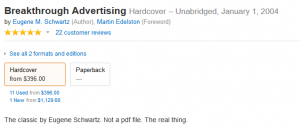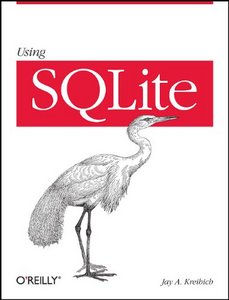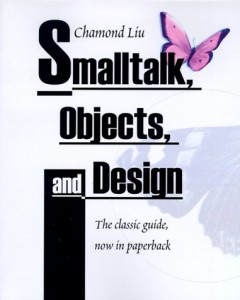Breakthrough advertising by Eugene Schwartz
 There’s a lot written about this book. I won’t go into detail. But one of the most stark things about this book is its high price (used hardcover costs $396.00):
There’s a lot written about this book. I won’t go into detail. But one of the most stark things about this book is its high price (used hardcover costs $396.00):

Some say this book made the most millionaires. Some say it made their career. So what it is about?
the copy writer does not create the desire of millions of women all over America to lose weight; but he can channel that desire onto a particular product, and make its owner a millionaire
This is probably one of the main points in this book. Creating trends is incredible hard, riding them not so much.
All in all, I think it’s an incredible book. It’s truly a manual to make money. That doesn’t mean that you can just grab the book and money is pouring out but the books describes in depth each step in writing copy and explains strategies in detail.
Analysis is the art of asking the right questions and letting the problem dictate the right answers.
Mass desire
- copy channels desire onto a particular product but doesn’t create it
- Mass desires are the pubic spread of private wants
- Using these trends allows for leverage
- a) permanent forces: health, -technical problems => differentiates of the product + freshness
- b) forces of change: detect & chart possible trends
Stage I: Choose the most powerful desire that can possibly apply to your product
Each desire has three dimensions:
a) urgency, intensity, degree of demand to be satisfied aka. pain level
b) staying power, degree of repetition, the inability to become satiated aka. frequency of pain
c) scope aka. how many people have this problem
Stage II: Acknowledge the desire (reinforce it / offer means to satisfy) in the headline
Stage III: Show how your product performances satisfy the desire
a) Start by listing all different performances it contains and group them against the mass desires each satisfies
Your prospect’s state of awareness
You copy connects the market with the product. Your headline is the first step.
The headlines is based on three questions:
a) What is the mass desire that creates this market?
b) How much do these people know about the way your product satisfies this desire?
c) How many other products have been presented to them before yours?
How aware is your prospect?
I) Customer knows your product and what it does and knows he wants it
II) Customer knows the product but doesn’t want it yet
Your headline should focus on one of these tasks:
a) reinforce desire
b) sharpen / extend the image of the product
c) introduce new proof / details
d) announce new mechanism for better satisfaction / elements former limitations
e) completely change the image (USP)
You use the brand name / logo and point out the product’s superiority
III) Customer knows that the wants the product but he doesn’t know yet that there’s a product
IV) Customer has a need but doesn’t understand the connection between him and the product
Start with the need / solution in the headline. Dramatize the need and present the product as the inevitable solution
V) Prospect isn’t aware of his need or he won’t admit it // need is very general
a) Price means nothing yet
b) The name means nothing
c) Function and desire mean nothing
You are echoing your market (emotional, attitude). You are defining them for themselves. The reader has to own the headline: his headline, his problem, his state of mind.
You’re not selling the product, you are selling the ad. Your goal is that they keep on reading to that they can get through each awareness phase.
THE UNIVERSITY OF THE NIGHT
The young Lincoln, poring over borrowed school-books far into the night – seeking in the dim light of his log fire the transforming light of knowledge – eager to grow – eager to do . . . here is an example which has inspired the man who strives against the odds of circumstances to make his place in the world.
To-night, in cities and towns and villages . . . thousands of men will drop their daily labors to fight, beneath the lamp, the battle that Lincoln fought. . .
Up from the mines, down from the masts of ships . . . from all the places where men work, they will go home and take up their books because they yearn to grow, because they seek higher training, greater skill, more responsibility. . .
Some of them are men who work in one field whereas their talents and desires are in another. Some . . . are halted in their progress because they do not understand the higher principles of their business or profession. Some left school in boyhood because poverty made it necessary. . .
Fifty years ago these men . . . would have had no place to turn for the courses of study and for the personal guidance that they need.
Thirty years ago there was founded a school to help them – a school created for their needs and circumstances – a school that goes to them no matter where they are – a school . . .
Created in response to a need, the International Correspondence Schools have developed their scope and usefulness to the growth of that need . . .
How many products have been there before you?
I: First to market
If prospects learn about your product, they become more interested, more enthusiastic and believe more
Be simple, be direct, don’t be fancy; dramatize the claim, bring your product and prove that it works
II: You’re second
If the direct claim (I) still works
copy it and enlarge on it; drive it to a limit
III: People already bought products and (II) is at its limit
People accept their fate but still have the desire; they are looking for something new
Introduce a new mechanism; shift from what the product does to how it works; reduce the claim from (II) down and integrate it; e.g. „I am 60 pounds lighter“ => „lose fat“; integrate the claim into your first paragraph
IV: Elaboration on the new mechanism
Make it easier, quicker, surer, solve more problems, overcome old limitations, promise extra benefits (like II)
V: Dead market
Use the technique of fifth awareness phase
38 ways to strengthen your headline
I. Verbalization
Reinforcing a claim by binding other images to it
- Measure the size of the claim
- Measure the speed
- Compare it
- Metaphorize it
- Make the prospect feel, seek, touch, see or hear it
- Show prime examples
- Dramatize the claim / results
- Use paradoxes
- Remove limitations
- Use people / values the prospect wished to be identified (celebs, professionals, etc.)
- Show how much the claim does in detail
- Use a question
- How to
- Use authority
- Before – After
- New, Now, announcing
- Stress exclusivity
- Turn the claim into a challenge for the reader (Does she or doesn’t she? Which?)
- Use quotations
- Symbolize the claim / find parallels
- Use contradictions to common sense
- Offer information
- Give the problem / need a name
- Warn about possible pitfalls if the reader doesn’t use the product
- Break the claim into two sentences or repeat (part of) it
- Compare your product to other usages (if you can count to …)
- State the difference
- Surprise the reader that former limitations that have now been overcome
- Address people who can’t buy your product (If you already…)
- Address the prospect directly
- Dramatize how hard it was to produce the claim (When X did A we had to …)
- Accuse the claim of being too good
- Challenge the prospects present limiting beliefs
- Turn the claim into a Q&A
The Art of Creative Planning
I: Word-Substitute technique: Use headline substitute words
II: Use formulas
III: Analytical approach (see above)
A man will not visualize future disasters occurring to himself, but he is perfectly capable of visualizing, and buying preventative from, the image of such future problems affecting others around him.
Inside your prospect’s mind — what makes people read, want, believe
I. Desires
expand, sharpen, channel them and give them a goal
Your prospect must want
II. Identifications
roles or traits the prospect wants
your product must represent
III. Beliefs
opinions, attitudes, prejudices, etc your prospect lives by
your product must fit
Intensification
- fill out vaguest desires with concrete images
- your writing the scripts of your prospect’s dreams (xI000)
When limited space:
- Compression: boiling down into key words
- The campaign: Repetition of key words with progression
I. Present the product / result directly by a thorough, completely detailed description of its effect
II. Put the product in action / describe what will happen to him
-
Let your reader visualize himself proving the performance of your product (provide a test) in the most specific and dramatic way
-
Extend the vision over a longer time horizon
-
Viewpoint from someone your reader can identify with (ordinary people, experts, celebs)
-
Use the disadvantages of the old product as compare it to the new one
 I didn’t know much about this book. I knew that it was written by two Googlers. It was under 200 pages. And the title was intriguing. Sounded great, let’s see how good it is.
I didn’t know much about this book. I knew that it was written by two Googlers. It was under 200 pages. And the title was intriguing. Sounded great, let’s see how good it is.



